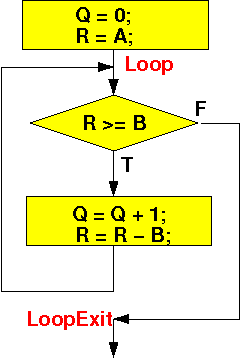while ( condition ) +---------->|
statement | |
| +--------------+ FALSE
| | condition |--------+
| +--------------+ |
| | |
| | TRUE |
| | |
| V |
| statement |
| | |
+-----------+ |
|
+<---------------+
|
V
LOOP:
+--> Evaluate "condition" (CMP)
| |
| V
| Branch on the FALSE outcome of "condition" to A ------------+
| | |
| | TRUE |
| | |
| V |
| Translate "statement" into assembler code |
| | |
| V |
+--------- BRA LOOP |
|
A: +<------------------------------------------------+
|
V
int A, B;
int Q, R;
(Computes: Q = A/B
R = A%B)
Q = 0; MOVE.L #0, Q
R = A; MOVE.L A, R
while ( R >= B ) Loop: MOVE.L R, D0
{ CMP.L B, D0
Q = Q + 1; BLT LoopExit
R = R - B;
} MOVE.L Q, D0
ADD.L #1, D0
MOVE.L D0, Q
MOVE.L R, D0
SUB.L B, D0
MOVE.L D0, R
BRA Loop
LoopExit:
The flow chart of the program segment:

|
The following assembler program does the same thing, just "faster". But since the focus of the course is understanding how the computer works, and not make it run faster, this program will not be discussed. If you're curious, take a look. Basically, don't use the memory if you don't have to: click here
- The while statement:
while ( C ) { s1; s2; ... }give rise to an assembler program with the following structure:
WhileStart: instructions to perform a compare specified by the condition C branch of FALSE of the condition C to label WhileEnd instructions to perform s1 instructions to perform s2 .... bra WhileStart WhileEnd:
- Note:
- The statements inside
the while body can be
"translated" into
assembler code
independently from
the while-statement
- Use this property to
handle:
- Nesting of a
while statment
inside another
while statment
- Nesting of a if/if-else statment inside a while statment
- Nesting of a
while statment
inside another
while statment
- The statements inside
the while body can be
"translated" into
assembler code
independently from
the while-statement